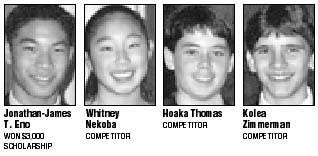Advertisement - Click to support our sponsors.


Jonathan-James T. Eno of Maui, a Baldwin High School ninth-grader known as "J.J.," said he went to a national science competition in Washington, D.C., "just to have fun." Maui student places
third in national
science contestBy Helen Altonn
Star-BulletinSo he was shocked to place third out of 40 national finalists in the second annual Discovery Young Scientist Challenge.
He won a $3,000 scholarship that he plans to use for college studies -- either to be an orthopedic surgeon or an electrical engineer.
Eno was nominated to participate in the national competition because of his project in the last Hawaii State Science and Engineering Fair, a Hawaii Academy of Science program.
Other Hawaii finalists selected for the national competition were Kolea Zimmerman and Whitney Nekoba of Waiakea High School on the Big Island and Hoaka Thomas of St. Ann's School in Kaneohe.
Eno was curious about whether plants and grasses could aid in the phytoremediation process, in which plants clean soil. His project, "Phytoremediation of Hydrocarbon Contaminated Soil," showed plants do help to eliminate contaminants in the soil.
Zimmerman won a special award at the national event for his project in search of a new form of antibiotic -- an idea that stemmed from his interest in mining for wild mushrooms and other fungi. His project was called, "Mycoprospecting in Hawaii: A Search for Antibiotics in the Xylariaceae."
He tested antibacterial properties in the fungi Xylariaceae and found that of 11 forms, two produced antibiotic properties against bacteria.
Zimmerman will spend a week next summer working with scientists from the University of California-Santa Barbara's Marine Science Institute.
All-expense-paid trips were provided for the four isle students and accompanying adults to compete in the final challenges at the Smithsonian Institution.
The students worked with Smithsonian scientists in public and private research laboratories, using the museum's private collections.
Eno said he was nervous about competing "with 40 of the best young scientists from across the nation," but many became new friends.
Eno, Nekoba and Zimmerman said the greatest challenge was to give an eight-minute oral presentation on their projects.
Another challenge: A requirement to wear a suit and tie for the presentation, a dinner at the Capitol and the awards ceremony.
"It's pretty much the first time I ever wore a suit," Eno said.
The students were also given six fish preserved in alcohol. They had to identify them, based on their features, say where they lived in the ocean and at what depth.
They also had to identify a set of bones -- an easy challenge for the Maui student.
"It ended up being a baleen whale," Eno said. "Being from Hawaii, we see more whales than people from the mainland."
In another task, the students had to describe the material and dyes used in a replica of Old Glory, and the kind of stains that were on it.
They were able to use Smithsonian exhibits for research to resolve the challenges, Eno said.
Also, he said, "We had a great opportunity -- we were able to go behind in the labs where only scientists are able to go. It was a great experience."
Zimmerman said the youths were followed everywhere by photographers and videocameras. "This was one of the best trips we had ever taken."
Nekoba said the experiences "will last a lifetime in my heart."
Kay Aratani, director of the Hawaii State Science and Engineering Fair, said she was "completely surprised" at how well Hawaii's students did in the national competition.
"I know that our students do good work," but this was just the second year of the middle-school competition, she said.
"I would have been pleased with one finalist, but somehow we got four altogether ... Their teachers worked directly with them. They certainly did an excellent job."